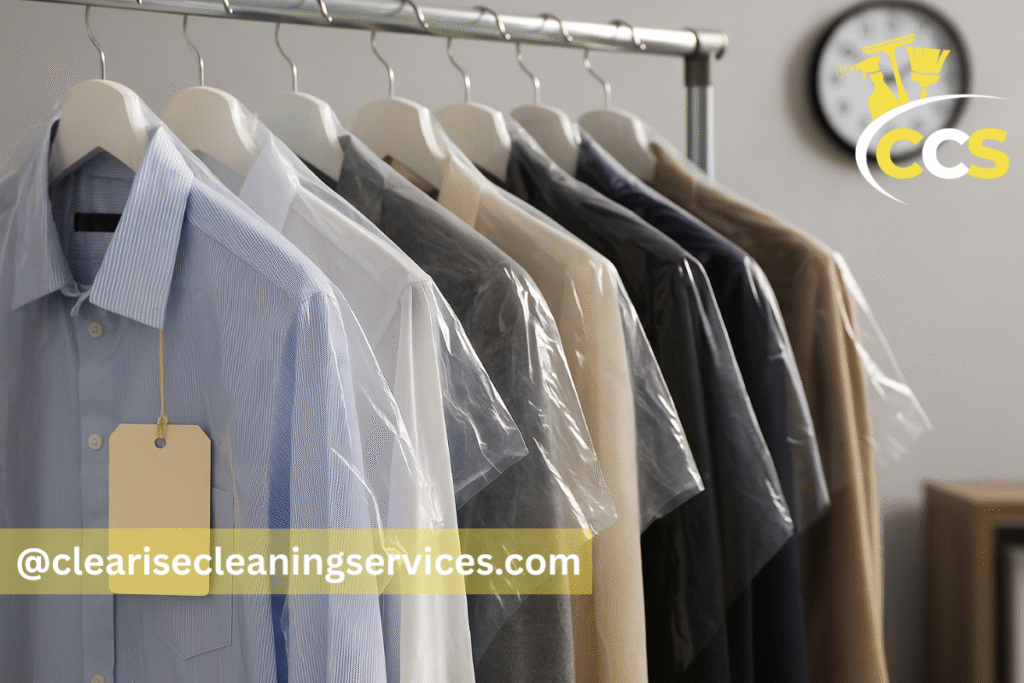You drop off a suit or a delicate dress at the local cleaner and the first thought that crosses your mind is, “how much is dry cleaning going to cost me this time?” It’s a common question, and one that doesn’t always have a straightforward answer.
Dry cleaning plays a bigger role in our lives than many people realize. From keeping work clothes sharp to preserving special garments, the price you pay affects both your household budget and the life of your wardrobe. For new parents, professionals, or anyone juggling busy routines, understanding the real cost can help avoid surprises and make smarter choices about where and how often to clean your items.
In this article, we’ll break down the factors that influence dry cleaning prices, explore how costs vary by region and garment type, and share insider tips from industry professionals. By the end, you’ll have a clear, practical guide that answers the question: how much is dry cleaning — and how to get the best value for your clothes.
What Is Dry Cleaning — A Quick Primer
Definition and Distinction from “Wet” Laundry
Despite the name, dry cleaning isn’t completely “dry.” Instead of using water and traditional detergents, cleaners use special chemical solvents that dissolve dirt, oils, and stains without soaking the fabric. This process is gentler on delicate materials like silk, wool, or rayon. In contrast, wet laundry relies on water, detergent, and agitation — a method that can cause certain fabrics to shrink, lose color, or lose their shape.
Why Some Clothes Are Labeled “Dry Clean Only”
If you’ve ever wondered why a label insists on “dry clean only,” it usually comes down to fabric sensitivity. Natural fibers like silk, cashmere, and wool don’t react well to water and heat. Structured garments like suits, blazers, or dresses with lining can also lose their crisp form in a washing machine. Dry cleaning preserves the texture, fit, and overall integrity of these garments, keeping them looking fresh and lasting longer.
How the Process Actually Works
The typical dry cleaning cycle has three stages:
- Solvent cleaning: Clothes are placed in a large drum machine filled with liquid solvent instead of water. This solvent lifts stains, body oils, and dirt from the fibers.
- Rinsing and filtering: The solvent is filtered and reused, while soils and residues are separated out.
- Pressing and finishing: After cleaning, garments are pressed, steamed, or hand-finished so they look polished and ready to wear.
In recent years, many cleaners have shifted away from traditional perchloroethylene (known as perc), a solvent linked to environmental and health concerns. Alternatives such as hydrocarbon-based solutions, silicone solvents, or even advanced “wet cleaning” techniques are becoming more common. These options can be safer and more eco-friendly, but they sometimes come with a slightly higher cost.
Why Cost Is More Than Just “Washing”
The price you pay for dry cleaning isn’t only for stain removal. Behind the counter, there’s a lot happening that adds to the bill:
- Specialized equipment: Dry cleaning machines are expensive, highly regulated, and require constant upkeep.
- Chemicals and solvents: Quality solvents and their safe disposal add to operating costs.
- Labor and expertise: Professional cleaners spend time spotting stains, treating delicate fabrics, and hand-finishing garments.
- Environmental and safety regulations: Many regions have strict laws about handling and disposing of solvents, which cleaners must follow.
All of these factors mean that dry cleaning is less about a quick wash and more about skilled garment care — which explains why costs vary depending on the service, location, and garment.
Key Factors that Influence Dry Cleaning Cost
Dry cleaning isn’t priced with a simple “one size fits all” approach. The cost depends on a mix of factors — from what you hand over at the counter to where the cleaner is located. Understanding these details will help you make sense of price lists and quotes.
Garment Type & Complexity
Different garments require different levels of care. A plain cotton shirt will usually cost far less than a full-length wool coat. Complexity also matters. Linings, pleats, intricate stitching, or delicate buttons require extra time and attention, raising the price. For example, a simple blouse might take minutes, while a tailored suit with lining can take hours to clean, finish, and press properly.
Fabric and Material
Fabric type is one of the strongest cost drivers. Natural fibers like silk, wool, or cashmere are delicate and demand careful handling. They can’t be rushed or treated with harsh chemicals. On the other hand, synthetics and blends are often easier and quicker to clean. Specialty items such as leather, fur, or suede need unique treatments and can cost several times more than standard fabrics.
Stains, Soil Level & Pre-Treatment Needs
Not all stains are created equal. Ink, oil, wine, or set-in food stains often require special spot treatments before the garment even reaches the machine. If a piece is heavily soiled, cleaners may need to repeat cycles or hand-treat problem areas. Each of these steps adds to labor and, naturally, to the final cost.
Cleaning Method & Technology
The type of cleaning system used also affects pricing. Traditional cleaners using perchloroethylene (perc) may charge less, but many modern shops invest in greener solvents such as hydrocarbon or silicone-based solutions. Some even use advanced wet-cleaning technology, which is more environmentally friendly but requires skilled staff and higher equipment costs. Eco-friendly and boutique cleaners often charge a premium for these specialized services.
Finishing, Pressing & Hand Work
Dry cleaning is more than stain removal. Pressing, steaming, and finishing garments to look crisp and wrinkle-free takes significant skill. Hand-finishing for pleats, collars, or delicate folds requires even more time. A professional finish is one of the main reasons customers are willing to pay more than they would for at-home washing.
Location & Market / Overhead Costs
Where you live has a big impact on how much dry cleaning costs. In urban areas, cleaners pay higher rent, labor, and utility bills, which translates into higher service charges. Local competition also plays a role — in a city with dozens of cleaners, prices may be more competitive than in a small town with just one shop. Regulations, waste disposal, and licensing requirements can further increase costs in certain regions.
Volume / Membership / Subscription Models
Some cleaners offer volume discounts, subscription plans, or per-pound pricing to regular customers. A loyalty program or monthly membership may lower your average cost per item. Families or professionals who frequently clean multiple garments can benefit from these plans, reducing what they spend in the long run.
Turnaround Speed & Specialty Services
Time is money, and it’s no different in dry cleaning. Same-day or rush services almost always carry an extra fee. Additional conveniences like pickup and delivery, after-hours drop-offs, or garment storage also add to the bill. While these services can save you valuable time, they do come at a premium.
Typical Price Ranges (with Examples)
Now that we’ve covered why prices vary, let’s look at what you might actually expect to pay. Keep in mind that these numbers are averages; actual costs depend on the cleaner, the city, and the garment itself. Always check your local price list before dropping off clothes.
Price Ranges in the U.S. (by Garment)
Here are the typical ranges you’ll see across most American dry cleaners:
- Shirt: about $2 to $5 each — though in busy metro areas, prices may climb closer to $6–$7.
- Pants / Slacks: usually $4 to $15 depending on fabric and finish.
- Suits (2-piece): around $10 to $30+ for standard business suits. Three-piece or designer suits can cost more.
- Dresses: anywhere from $10 to $30–$50+ depending on style and delicacy. A cocktail dress may be on the lower end, while evening gowns fall much higher.
- Coats / Jackets: generally $10 to $25+, with heavier winter coats or long wool coats at the top of the scale.
- Specialty items: wedding gowns, leather jackets, fur, down comforters, or upholstery covers can cost $50 to several hundred dollars because of the specialized handling required.
Sample Local Price Lists (U.S.)
Looking at actual cleaner websites helps illustrate the differences:
- Colvin Cleaners (Buffalo, NY): Shirts at $2.95, pants at $6.50, suits at $14.50, coats around $15–$20.
- Classic Cleaners (Indianapolis, IN): Slacks around $7.25, blazers $8.75, dresses $14.50–$20+.
- Victoria Cleaners (Kansas City, MO): Pants and skirts $6–$7, suits $12–$14, specialty dresses from $18+.
- Perfect Cleaners (Los Angeles, CA): Pants at $7.95, dresses starting at $13.95, suits $16.95–$19.95.
- Mulberry’s (Washington, D.C. & San Francisco Bay Area): Known for eco-friendly service, shirts start at $4.49, pants at $8.99, dresses $17.99+, and coats $19.99+.
These examples highlight how location and service type play a big role in pricing.
What These Numbers Mean for a Typical Dry Cleaning “Trip”
Most people don’t bring just one item to the cleaner. A bundle of 3–5 items — say a suit, two shirts, and a pair of pants — can easily add up to $25–$50 per visit. If you need extras like stain removal, same-day service, or delicate finishing, expect the bill to go higher.
Price Variation by Region / City / Country
The phrase “dry cleaning prices near me” often pulls up a wide range of numbers. That’s because local costs vary drastically:
- In large metro areas like New York, Los Angeles, or Washington, D.C., prices run higher due to overhead costs.
- In smaller towns, you may pay 20–30% less for the same service.
- Internationally, prices also vary. For example, in Islamabad and Karachi, dry cleaning a shirt can cost around 250–400 ($1–$1.50), while a men’s suit may run Rs. 1,000–2,000 ($3.50–$7). That’s lower than U.S. averages, but relative to local income, it still represents a significant household expense.
Specialty / Luxury Cleaning Premium
There’s a tier of dry cleaning that goes well beyond basic care. “Designer dry cleaning” or services aimed at bespoke tailoring often include:
- Stain removal and garment restoration for high-end fabrics.
- Re-dyeing or color revival for faded clothing.
- Delicate hand washing or preservation for wedding gowns, vintage garments, or couture dresses.
These services demand extra skill, equipment, and time — so don’t be surprised if the cost doubles or triples compared to standard rates.
Geo & Variant Queries — Satisfying Local & Long-Tail Searches
When people type questions like “dry cleaning prices near me” or “how much is dry cleaning in DC” into Google, they’re usually looking for location-specific answers. Costs can vary widely depending on the city, the cleaner, and even the type of garment. Below, we’ll address some of the most common location-based and item-specific queries.
How Much Is Dry Cleaning in Washington, D.C. (or Other Major Cities)
In larger metro areas such as Washington, D.C., prices are typically higher because of rent, labor, and overhead costs. For example:
- A shirt might cost $4–$6 at a central D.C. cleaner, compared to $2–$3 in a smaller town.
- A two-piece suit could run $15–$25 at an independent shop and closer to $30+ at boutique or eco-friendly cleaners.
Chain vs Local Shops: National chains may offer slightly lower rates due to scale, while family-owned or boutique shops often charge more but deliver personalized care and higher finishing quality.
Dry Cleaning Prices Near Me / Best Dry Cleaning Prices Near Me
When comparing “dry cleaning prices near me,” don’t just click the first Google result. A smarter approach is:
- Call ahead: Ask for itemized prices by garment type.
- Check websites: Many cleaners post price lists online.
- Visit in person: Some cleaners adjust pricing based on garment details once they see the item.
Checklist: Always ask about service fees, sales tax, and extras (stain removal, pressing, rush orders) so there are no surprises on the bill.
Same-Day / Rush / Express Dry Cleaning
If you’ve got a last-minute meeting or event, same-day cleaning can be a lifesaver. But speed costs extra. In most cities:
- Expect to pay a 15–25% premium for express service.
- Some shops add a flat $5–$10 rush fee per order.
- Turnaround trade-off: garments may not receive as much hand finishing, so results can vary compared to standard service.
Zips Dry Cleaners / Zips Dry Cleaners Near Me
Zips Dry Cleaners is a well-known U.S. chain that advertises flat-rate pricing, often around $2.99 per garment (though this may vary by location). They attract customers with affordability and speed, but reviews sometimes note less personalized attention compared to boutique cleaners.
Comparison:
- Zips and other chains: Budget-friendly, fast, predictable flat rates.
- Independent shops: Higher cost, but more likely to specialize in stain removal, delicate fabrics, or couture items.
How Much Is Dry Cleaning a Sweater
Sweaters usually fall into the mid-range price bracket. Their knit structure requires careful handling, especially with wool or cashmere. On average:
- Basic synthetic sweater: $4–$6
- Wool or cashmere sweater: $6–$10+
Extra treatments for stains or mothproofing may push costs higher.
Average Dry Cleaning Cost for a Suit
Suits are one of the most common garments sent for dry cleaning. A typical two-piece business suit runs $10–$30 depending on the fabric and location.
- A three-piece suit can cost more due to the vest being treated as an additional garment.
- Extras like pressing, lining care, or alterations (hemming, button replacement) are billed separately.
How Much Is Dry Cleaning Near Me / How Much Is Dry Cleaning Per Month
If you dry clean regularly — for example, a week’s worth of office attire or uniforms — the costs can add up quickly. Here’s a sample estimate:
- Cleaning 5–7 items per week (suits, shirts, slacks) can run $100–$200 per month in most U.S. cities.
- Subscriptions or loyalty programs may lower this by 10–20%.
- Consolidating drop-offs (bringing in multiple items at once) is often more cost-effective than sporadic single-item visits.
Tips from Experts & Insider Hacks
Dry cleaning can feel like a mystery if you only see the counter and not the work behind it. As someone who’s handled delicate fabrics and stubborn stains for years, I’ve learned that a little preparation and knowledge can save both money and frustration. Here are some expert-backed tips every customer should know.
How to Get an Accurate Quote
One of the most common complaints customers have is being surprised at checkout. To avoid that:
- Ask for itemized pricing: Don’t just ask “how much is dry cleaning?”—ask specifically about shirts, suits, dresses, or coats.
- Disclose details upfront: Mention stains, delicate fabrics, or decorative embellishments like sequins or beading. These often need extra work.
- Ask about “press only” services: Sometimes your garment doesn’t need a full clean, just pressing to remove wrinkles. This option is usually cheaper.
Negotiate or Use Membership / Subscription Deals
Many cleaners reward loyal customers.
- Membership plans or loyalty cards often come with discounts after a set number of visits.
- Bundle items together: Instead of dropping off one or two garments at a time, bring several pieces in one order. This helps you negotiate a lower rate.
- Look for monthly subscriptions: Some shops offer flat-rate services for unlimited or set-volume cleanings.
Know When Not to Dry Clean
Believe it or not, not everything labeled “dry clean only” always needs professional care.
- Some synthetic blends can be hand-washed gently at home.
- Lightly worn garments may only need airing or steaming between professional cleans.
- But caution is key: Attempting to wash wool, silk, or structured suits at home risks shrinking, color bleeding, or distortion. When in doubt, consult your cleaner before experimenting.
Pre-Treat & Protect Garments at Home
A few small steps can save your clothes — and reduce your bill.
- Spot-treat minor stains (like a coffee drip) before they set in.
- Use garment bags to protect delicate items during storage and transport.
- Prepare items before drop-off: Zip up zippers, button shirts, and empty pockets so the cleaner doesn’t have to.
Maintain Garments Between Cleanings
Over-cleaning can wear down fabrics faster than dirt ever will. Instead:
- Air out clothes after each wear instead of tossing them into a hamper.
- Use a steamer to refresh garments and remove light wrinkles.
- Spot clean carefully for small marks to avoid unnecessary full cleans.
This not only keeps clothes fresh but also saves money by reducing visits.
Select a Trustworthy Cleaner (EEAT Perspective)
Not all cleaners are created equal. Choosing the right one makes all the difference.
- Check credentials and certifications: Some cleaners belong to professional associations that uphold higher standards.
- Ask about their solvents: Eco-friendly solvents are safer for fabrics and the environment, though sometimes pricier.
- Look at reviews and references: Word-of-mouth or verified online reviews reveal a lot about reliability.
- Ask about guarantees: A good cleaner will stand by their work and address issues promptly.
Troubleshooting & Dealing with Damage, Shrinkage, or Lost Items
Unfortunately, accidents can happen. If your garment is damaged or misplaced:
- Act quickly: Report issues as soon as you notice them.
- Know your rights: Many cleaners carry insurance for lost or damaged garments.
- Be polite but firm: Ask about compensation or repair options. Professional shops often try to make things right.
Cost-Benefit & Budgeting Perspective for New Parents
For new parents, every decision often comes down to two things: time and money. Between childcare expenses, household costs, and the daily juggle of work and family, dry cleaning can feel like just another bill. But when you look closely, it’s about more than cost — it’s also about protecting clothes, saving time, and choosing convenience wisely.
How “How Much Is Dry Cleaning” Fits into Household Budgeting
On average, a family that dry cleans suits, dresses, and coats regularly can spend $100–$200 per month in the U.S., or Rs. 5,000–10,000 in Pakistan, depending on city and lifestyle. Over a year, that’s easily $1,200–$2,400.
- Alternatives to compare:
- At-home washing: Cheaper but not safe for delicate or structured clothes.
- Laundry service or “wash & fold”: Convenient for daily wear but may not provide the same finishing.
- Dry cleaning subscriptions: Can lower average monthly costs if you’re a frequent customer.
For parents on a budget, estimating annual dry cleaning expenses upfront helps avoid surprises and leaves room for smarter planning.
When to Opt for Cheaper Alternatives or In-House Care
Not every garment deserves a trip to the dry cleaner.
- Everyday clothes: Cotton shirts, jeans, or casual wear can usually be laundered at home or with a standard laundry service.
- Special garments: Suits, silk dresses, coats, and anything labeled “dry clean only” should go to a professional.
The rule of thumb: if the garment is expensive to replace or carries sentimental value, let the pros handle it.
Convenience vs Cost — Which Trade-Offs Make Sense for Parents
When you’re juggling family life, time is as valuable as money.
- Pickup & delivery services: Perfect if you can’t squeeze in another errand, but they often cost extra.
- Drop-off and standard service: Cheaper, but requires more planning and time.
- Turnaround time: Same-day or express service might be worth the premium for emergencies like an important work meeting or family event.
Each parent has to balance whether the time saved justifies the extra expense.
When Investing in Quality Pays Off
Dry cleaning can feel like a luxury, but sometimes it’s an investment.
- Expensive garments: A tailored suit, an evening gown, or a high-quality winter coat lasts longer when cared for properly.
- Maternity wear: These clothes often use stretchy or delicate fabrics that can lose shape in regular washes.
- Baby’s clothes: While most everyday baby clothes can be machine washed, heirloom pieces (like christening gowns) deserve professional preservation.
In the long run, paying a little more for proper care extends the life of garments and reduces replacement costs — something every budget-conscious parent can appreciate.
Conclusion
So, how much is dry cleaning? The honest answer is: it depends. Prices vary by garment type, fabric, stains, location, and the level of service you choose. A simple shirt may cost just a few dollars, while a wedding gown can run into the hundreds.
The key is to shop smart: compare local price lists, ask for itemized quotes, and understand what’s included in the service. Don’t be afraid to ask about memberships, turnaround times, or solvent types.
Before you drop off your next load, take a moment to evaluate your options. A little preparation ensures you get fair pricing, trustworthy service, and clothes that last longer. That way, the next time you ask “how much is dry cleaning,” you’ll already know the answer — and how to get the best value for your wardrobe.
FAQs
Is Dry Cleaning Expensive? Why So?
Dry cleaning may seem pricey compared to home laundry, but you’re paying for specialized solvents, skilled labor, high-tech equipment, and regulatory compliance. It’s less about “washing” and more about professional garment care.
Can I Wash “Dry Clean Only” Clothes At Home?
Sometimes, but with risk. Certain synthetic blends may survive gentle hand washing, but wool, silk, and structured suits often shrink, lose color, or lose shape. When in doubt, consult your cleaner first.
Does More Expensive Always Mean Better?
Not always. Higher costs often reflect eco-friendly solvents, boutique finishing, or premium customer service. But a mid-priced, well-reviewed cleaner can deliver excellent results too.
Why Did My Dry Cleaner Charge Extra Than Quoted?
Extras like stain removal, delicate fabrics, embellishments, or rush service can raise costs. Always ask for a full estimate and itemized pricing before drop-off to avoid surprises.
How Often Should I Dry Clean My Suit Or Coat?
- Suits: every 3–4 wears, or sooner if stained.
- Coats: once or twice a season, depending on use.
Over-cleaning shortens fabric life, so balance freshness with preservation.
Disclaimer: The information provided in this article is for general educational purposes only and should not be taken as professional or financial advice. Dry cleaning costs vary by location, service provider, fabric type, and individual garment needs. Prices and examples mentioned here are approximate and may change over time. Always consult a trusted local dry cleaner for accurate estimates and professional guidance specific to your clothing. The author and publisher are not responsible for any decisions, expenses, or outcomes resulting from the use of this information.
Thanks for visiting Clearise Cleaning Services! Discover more helpful tips and expert cleaning insights by exploring our related categories.




